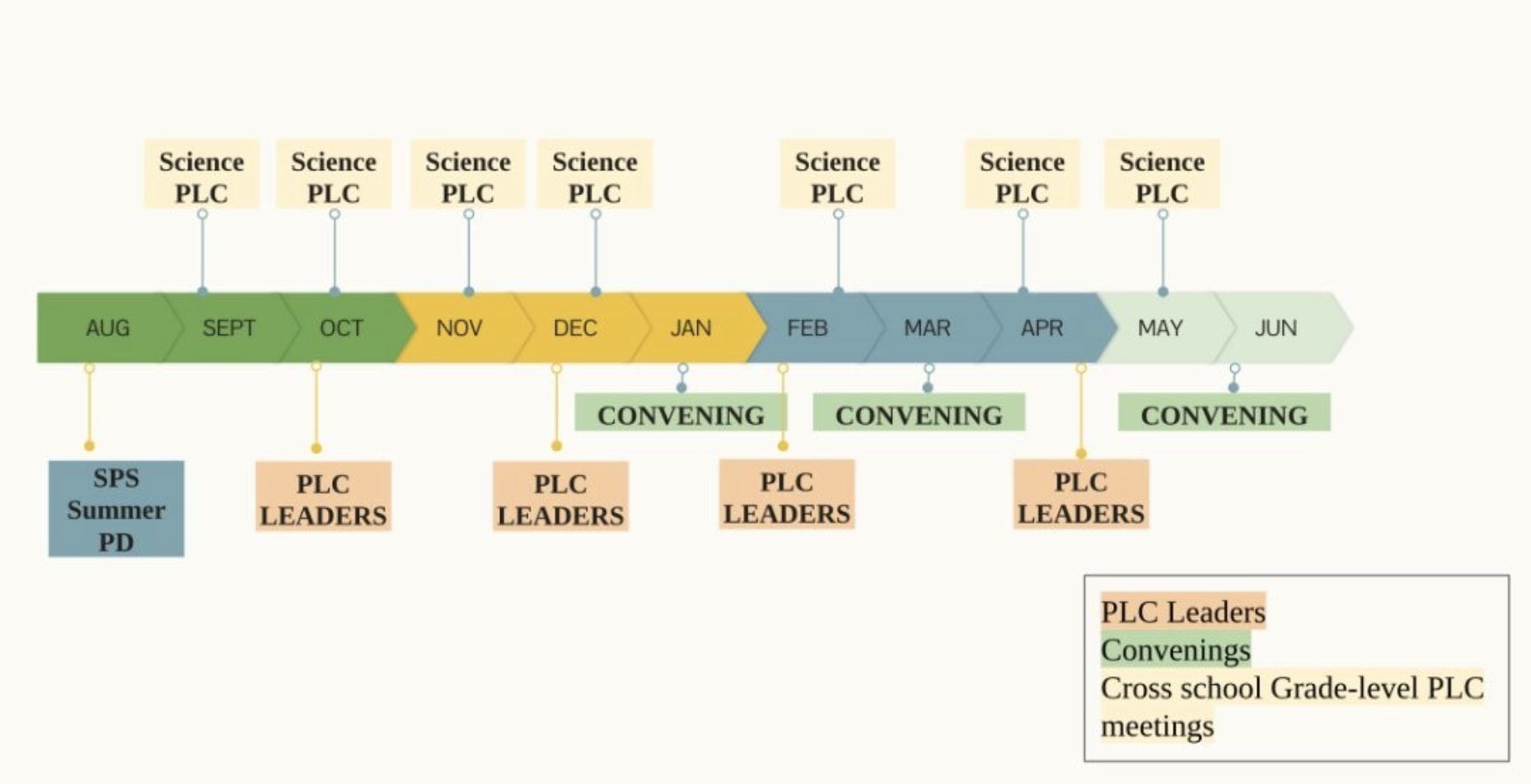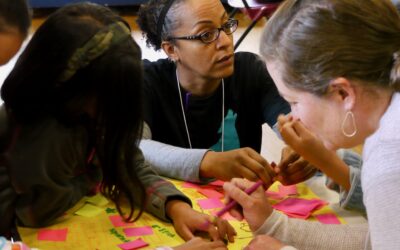Supporting Professional Learning Communities in Working Toward Justice-centered Science Teaching
Julia Ward1, Liz David1, Bethany Sjoberg1, Debbie Diaz1 & Jessica Thompson2
Seattle Public Schools1 & University of Washington2
In this case, we explore two questions important to our professional learning design within our university-school district research-practice partnership:
- How do teacher communities make sense of equity and justice in Professional Learning Communities (PLCs) and their classrooms?
- As facilitators, how and when do we share equity theories/frameworks and provide opportunities for teacher sensemaking?
Context
Seattle Public Schools has partnered with the University of Washington Ambitious Science Teaching group for five years. As district curriculum specialists and researchers, we aimed to partner with teachers to learn what ambitious and equitable science teaching could look like at the elementary level and to build capacity for teacher leadership. This last year, we have made headway in co-developing a vision of equity with teachers. This year, we have five groups of teachers organized into grade-band PLCs; they meet monthly to share videos and problems of practice from their classrooms.
Our vision of equity
We come to this work as teacher educators and former teachers who believe our most important ethical and moral responsibility is to honor the dignity and agency of students, families, and local communities by providing equitable learning spaces in classrooms and professional learning. We are partnering with teachers to develop an expansive vision of equity in science while looking critically at our own positionality as facilitators of professional learning as a step toward working toward a more just future. There are many inequitable dimensions of science and science teaching, and this project focuses specifically on developing equitable science classroom learning communities and professional learning communities. We are co-developing three interrelated lines of inquiry with teachers in their PLCs, focusing on classroom communities that
- build expansive scientific explanations,
- value students’ resources and funds of knowledge and
- examine the role of power in classrooms, science, and society.
PLC Design
Thirty elementary teachers joined the Science Teacher Leader Professional Learning Community this year. PLCs were organized with cross-school participants in grade-level groups, with each group having at least one of the teachers serve as a facilitator. A district-level science curriculum specialist also joined each PLC and served in a supporting role for the facilitator. This included helping with film classrooms and planning for the PLC.

A pivotal moment in our learning: From the theory-practice divide to teacher sensemaking
Reflecting on our journey in supporting teacher learning, we had one significant moment that stood out. It allowed us to pause and reflect on how we support teachers in working toward justice. During our convening in January, we shared resources about the lines of inquiry (linked above). Teachers dug in and considered classroom examples. In a PLC following the convening, teachers turned to Julia, a curriculum specialist, expecting her to define justice and equity. It seemed like they wanted concrete tools and terms to be defined by her, but a conversation where teachers engaged in sensemaking ensued. Specifically, in the consultancy part of the protocol, after a teacher shared a video from their classroom, the teachers shifted from wanting to be “told” the right answers to crafting their own definition of what it means to have all students participate in a lesson. Below, we share the consultancy task and dialogue from their conversation.

Teacher Facilitator: I still feel like we need some more research. Maybe Julia, that could be part of the next meeting. This justice-centered teaching and learning, I’m not so sure still what that is. I mean, I kind of get it, but I don’t fully get it. So I know if there’s more research we can get on that, maybe you all have other ideas. I don’t know.
Specialist: I’m gonna make a note of that right now.
Teacher 1: I mean, I guess the cubes that you used and the color coding, I mean, that stands out to me as a way to make, you know, bring equity to voice in the conversation. I don’t know who your students furthest from educational justice were in that based on that clip and like who I couldn’t see talking, but just having that sort of equity-based like sticks or cubes or color system to who speaks, I think, speaks to that first one [referencing the first question on the consultancy slide above].
Teacher 2: I think, like we talked about earlier too, it’s clear that the kids, there’s a culture of kids talking to each other and listening to each other. And so, like student voices, definitely are centered in your classroom. There were a couple of different times when a kid would say, “Well, my partner said,” without being prompted, and they just did that.
Teacher Facilitator: Yeah, there seem to be a lot of like truly listening to each other and sharing each other’s ideas.
Teacher 2: And it’s also clear that your expectation is that many different voices are heard. There are not just a couple kids that, you know, everyone should be depending on, even if maybe they think everybody should be depending on them, that like you expect a lot of different people to share their ideas. And listen to each other’s ideas.
Teacher 3: I also appreciated the culture of “It’s not just like one person says a right answer, and then you move on.” You really were in the conversation for a while, and people were sharing related ideas but in different ways, which I think does get at the justice-centered teaching and learning cuz, you know, just hearing it one time from one person might not totally connect with every kid. So it’s giving different people a chance to speak and also people a chance to hear the ideas in different ways and from different people.
Teacher Facilitator: And that part about “How does this lesson challenge how science is done?” Yeah, like more people are speaking, and the same ideas are said over and over and new ideas are valued. And yeah, awesome.
Teacher 2: I also think the knowledge isn’t coming from the teacher like the knowledge is really coming from the kids and their ideas. And that is important for them to see how science is done, that it’s all about the thinking of the scientist [referencing students as scientists]. And it’s not just it’s not just like information that’s handed to them.
In this conversation, the teachers started with a narrow idea of participation as equity sticks, then attempted to turn to the curriculum specialist for answers, then proceeded to expand their understanding of the purpose of having equitable participation in their classrooms. As they examined the questions “What did you see teacher/students doing that worked toward justice-centered teaching and learning? and How did the lesson challenge how is science done?” they created a shared understanding of equitable participation opportunities to move beyond “right answers,” shift authorship to students as scientists, and create opportunities for students to hear similar ideas, from different perspectives.
Our Journey toward Equity as Expansive and Justice-centered
The parallel of moving away from “a right answer” in the PLC and classroom conversations stood out to us. It made us, as a PL design team, consider how to have the PLC teams engage in more sensemaking conversations about their evolving definition of equity in science. We reasoned that we needed more opportunities for teachers to navigate the theory-practice divide, whereby equity frameworks/theories can be realized in the classroom. Drawing on the work of Hosun Kang and Erin Furtak, we shared and discussed this continuum with facilitators and then had teachers share classroom experiences along these lines. We noted that we needed more efforts to work toward justice and had a robust conversation about what this might mean for our practice. Specifically, we talked about using science and engineering as a means rather than an end toward a just future, incorporating youth activism, challenging our own and other’s assumptions, watching power dynamics in our classrooms, and the need to address histories and possible futures. Facilitators then had similar conversations in their PLCs, identifying what questions they tended to focus on to date, creating a vision statement, and deciding on the next steps.












 This site is primarily funded by the National Science Foundation (NSF) through Award #1907471 and #1315995
This site is primarily funded by the National Science Foundation (NSF) through Award #1907471 and #1315995